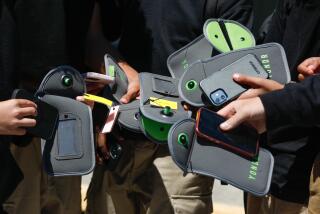FCC OKs Area Codes for Pagers, Cell Phones
- Share via
WASHINGTON — In a move likely to ignite an uproar among wireless users, the Federal Communications Commission said Wednesday that it will allow state regulators to seek new area codes exclusively for cellular phones and pagers.
The unanimous FCC decision is aimed at slowing the costly and disruptive nationwide explosion of area codes. Poor industry management of telephone numbers and a decade-long explosion of popular electronic gadgets, such as fax machines and cellular phones, are depleting the supply of area codes, experts say.
California, which was among five states that had asked the FCC for authority to implement specialized area codes, is among the hardest hit by phone number demand. The state has added 14 area codes since 1991, and some experts say a run on phone numbers in the Los Angeles-area 310 code and the 909 area code in San Bernardino County might trigger more additions, pushing the state’s area code total to more than 25.
“All of us share the frustration the public is experiencing with the proliferations of new telephone numbers and area codes, and each of these changes imposes costs and burdens on consumers,” FCC Commissioner Michael J. Copps said. “More [telecommunications companies] are providing services to consumers, and they all are demanding new numbers to give out to their customers.”
Until Wednesday’s vote, the FCC had banned technology-specific area codes, insisting they would be unfair because they require users to dial 10 digits for local calls.
As a result, states were forced to carve up phone-number strapped regions in one of two ways: They could split a geographic area in two and assign a second area code to one, or they could overlay an area code with a second one that would be assigned to any new numbers given out to business, residential and wireless users in the area.
Massachusetts, Virginia, Ohio, Texas, Oregon and Florida are among the states that have created new area codes by splitting or overlaying.
But the system has proved to be a costly stopgap. Each area code change costs companies as much as $40 million, according to a Pennsylvania estimate.
Under the new system, California’s Public Utilities Commission could either create one new statewide area code for all wireless devices, or create an overlay within existing area codes. PUC officials said Wednesday that they were studying the FCC’s ruling.
Over the last two years, the FCC has taken several steps to preserve the reservoir of phone numbers.
The agency has required states to dole out unused numbers to carriers in smaller allotments and asked the industry to use expensive new technology that would allow subscribers to keep their phone number when they switch carriers.
The wireless industry has long opposed device-specific area codes as costly and inconvenient.
“The wireless industry is acutely aware of the need for additional numbers. But as we bring new services and new choices to consumers, we must not punish them with onerous or discriminatory requirements such as 10-digit dialing,” said Tom Wheeler, president of the Cellular Telecommunications & Internet Assn., a Washington trade group.
With tens of millions of Americans signing up for cellular service and pagers annually, several new special area codes are likely to be required to meet the demand for wireless numbers.
The FCC said requests to assign area codes exclusively to wireless phones and pagers would be considered on “a case-by-case basis.”
FCC officials said they will consider whether carriers have first tried to conserve phone numbers.
The agency said it will favor plans that use the special area codes only as a temporary measure as the telecommunications industry implements more efficient conservation methods.
An official of the California PUC reacted cautiously to the decision.
“It offers the potential for us to use another mechanism to solve our area code problem,” said Helen Mickiewicz, deputy general counsel of the PUC.
More to Read
Sign up for Essential California
The most important California stories and recommendations in your inbox every morning.
You may occasionally receive promotional content from the Los Angeles Times.









